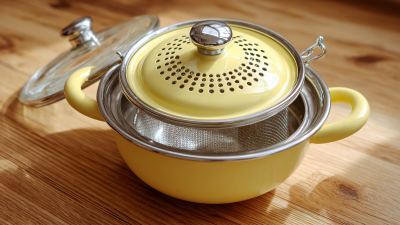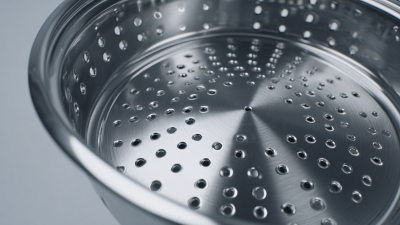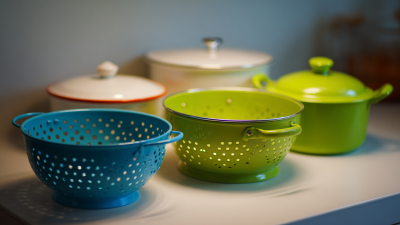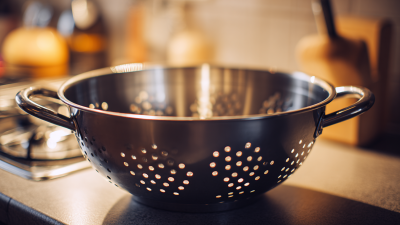Welcome to this website!

In the ever-evolving world of culinary arts, the significance of optimizing nutrient retention in our meals cannot be overstated. As more home cooks become interested in healthier cooking practices, the role of kitchen tools like the Food Strainer emerges as a game-changer. Renowned nutrition expert Dr. Lisa Houghton emphasizes this notion, stating, "Utilizing a Food Strainer not only enhances the texture and appearance of our dishes but also plays a crucial role in preserving the vital nutrients that our bodies crave."
When properly employed, a Food Strainer removes unwanted elements from fruits and vegetables while ensuring that essential vitamins and minerals remain intact. This technique allows for the creation of purees, sauces, and beverages that are both delicious and nutrient-rich, meeting the demands of health-conscious individuals.
Moreover, understanding the science behind how a Food Strainer functions can empower cooks to make informed choices in their meal preparation. By focusing on nutrient retention and leveraging the benefits of this essential kitchen tool, individuals can elevate their cooking to new heights, unlocking a world of healthier culinary possibilities.

Food strainers are often overlooked kitchen tools, yet they play a crucial role in enhancing nutrient retention during the cooking process. By effectively removing excess liquids and impurities from ingredients, strainers help maintain the essential vitamins and minerals that can easily be lost during cooking. Whether you're boiling vegetables or preparing stocks, using a food strainer allows you to preserve the nutritional value of your meals, ensuring that your dishes are not only delicious but also healthful.
Tip: When cooking vegetables, consider steaming them instead of boiling. Steam requires less water and reduces the time they are exposed to heat, helping to keep those vital nutrients intact. After steaming, use a food strainer to catch any drips and serve immediately for maximum health benefits.
Another way to leverage the power of food strainers is by using them to make homemade broths or sauces. By straining out solids, you can create smoother textures while retaining the flavors and nutrients from the simmered ingredients. This method not only enhances the taste but also ensures you're getting the most out of the ingredients you use.
Tip: Always rinse grains and legumes before cooking. This simple step helps remove anti-nutrients and debris, and a fine-mesh strainer is perfect for this task. Doing so will contribute to a healthier meal right from the start.
When it comes to healthier cooking, the right food strainer can play a significant role in nutrient retention and food preparation. There are various types of food strainers available, each designed for specific uses. For instance, fine mesh strainers are ideal for draining small particles from liquids, making them perfect for soups and sauces. On the other hand, colanders, with their larger holes, are better suited for rinsing pasta and washing fruits and vegetables.
**Tip:** Consider the material of your food strainer. Stainless steel options are durable and easy to clean, while silicone strainers offer flexibility and can withstand high temperatures. Investing in a good quality strainer can enhance not just the health benefits of your meals but also your overall cooking experience.
Another factor to keep in mind is the size of the strainer. A larger strainer can handle bigger batches, which is perfect for meal prep, while a smaller one may be sufficient for single servings. Choose wisely based on your cooking habits to maximize efficiency in your kitchen.
**Tip:** Always look for strainers that are dishwasher safe for easier cleanup. Regular cleaning will help prevent any buildup of residue that could affect the taste and quality of your food. Selecting the right food strainer will set you on a path to healthier cooking, making it easier to enjoy nutrient-rich meals.
When it comes to mastering cooking techniques that promote optimal health, food strainers play a crucial role. These handy kitchen tools are designed to separate liquids from solids, thereby preserving the integrity and nutritional value of ingredients. By using a food strainer, cooks can effectively retain vital nutrients found in the cooking water of vegetables or stocks, which might otherwise be discarded. This simple practice not only enhances the flavor of dishes but also ensures that essential vitamins and minerals are included in the meal.
Furthermore, food strainers facilitate the preparation of lighter, healthier meals by allowing for the removal of excess fats and impurities. For instance, when preparing homemade broths or sauces, straining can help achieve a smoother texture while eliminating unwanted particles. This technique invites the use of fresher ingredients and encourages a diverse palette of flavors, ultimately leading to a more wholesome dining experience. By incorporating food strainers into everyday cooking, individuals can take significant steps towards healthier eating habits and greater nutrient retention.
Straining food is not just a technique for removing unwanted particles; it can transform the flavor and texture of your dishes significantly. When you strain sauces or soups, you create a smoother texture that allows for more robust flavors to shine. For example, straining vegetable purees can enhance their creaminess, making them a delightful addition to any meal. Additionally, the process can help concentrate flavors, making every bite more satisfying.
**Tips:** To achieve the best texture and flavor in your dishes, always use the appropriate type of strainer. A fine mesh strainer is excellent for sauces and soups, ensuring a velvety finish, while a colander works well for pasta and beans. Experiment with the timing; straining foods too early can result in a loss of flavor as the juices haven't fully integrated yet.
Moreover, straining can also play a significant role in nutrient retention. For instance, when preparing stocks or broths, straining can help eliminate solids while preserving the rich nutrients that would otherwise get lost in the cooking process. This not only improves the overall quality of your dish but also contributes to a healthier meal.
**Tips:** Incorporate fermented foods that have been strained, like labneh, into your meals. These foods not only provide a tangy flavor boost but also come packed with health benefits. Straining yogurt to make labneh adds a unique texture and enhances its nutritional profile, reminiscent of other beneficial protein sources that lower heart disease risk.
| Strainer Type | Impact on Nutrient Retention (%) | Flavor Profile | Texture Improvement (%) | Recommended Uses |
|---|---|---|---|---|
| Fine Mesh Strainer | 90 | Delicate, Subtle | 85 | Soups, Sauces |
| Colander | 75 | Fresh, Bright | 70 | Pasta, Vegetables |
| Sieve | 80 | Rich, Creamy | 60 | Baking, Pudding |
| Nut Milk Bag | 95 | Nutty, Earthy | 90 | Nut Milks, Juices |
| Cheesecloth | 85 | Mild, Smooth | 65 | Broths, Infusions |
Food strainers are versatile kitchen tools that can significantly enhance the nutritional value of your meals by retaining essential nutrients. Innovative recipes that make use of food strainers can transform everyday ingredients into health-packed dishes. For instance, when preparing a vegetable broth, using a fine mesh strainer can help extract flavors while ensuring that beneficial vitamins from the vegetables remain suspended in the liquid rather than being left behind in the solids. This results in a nutrient-rich broth that can be used as a base for soups or sauces.
Another creative way to utilize food strainers is in smoothie preparation. By using a strainer to separate the pulp from fresh fruit juices, you can create a smoother consistency that is easier to digest while preserving the fiber content. Experimenting with different combinations of fruits and vegetables can lead to delicious, nutrient-dense smoothies that support a healthy lifestyle. Incorporating food strainers into your cooking routine not only enhances the texture and flavor of your dishes but also empowers you to maximize nutrient retention in your meals.






